Downing Recipient Qisen Song Reflects on Research Trip to Belgrade and Ljubljana
 I was honored to receive a 2019 Downing travel grant to conduct architectural site visits and archival research in Ljubljana, Slovenia, and Belgrade, Serbia, for my honors thesis. My thesis investigates the profound impact of political ideology on architecture with the comparison of the Great Hall of the People (1959) in the Tiananmen Square of early Communist China and the Federal Executive Council Building (1962), also known as the SIV Building, in the New Belgrade of the former Yugoslavia.
I was honored to receive a 2019 Downing travel grant to conduct architectural site visits and archival research in Ljubljana, Slovenia, and Belgrade, Serbia, for my honors thesis. My thesis investigates the profound impact of political ideology on architecture with the comparison of the Great Hall of the People (1959) in the Tiananmen Square of early Communist China and the Federal Executive Council Building (1962), also known as the SIV Building, in the New Belgrade of the former Yugoslavia.
My research in Belgrade was focused on the SIV Building itself, now the Palace of Serbia and host to the central government. After viewing many photographs of this landmark architecture, I still was overwhelmed by its gigantic scale and unparalleled monumentality.  Designed in an H-shape that covers an area of 65,000 square meters, this massive white complex envelops its visitors and immediately conveys the power of its nation. Office structures on either side and one multi-purpose pavilion in the center organize the space into a statement of modernism.
Designed in an H-shape that covers an area of 65,000 square meters, this massive white complex envelops its visitors and immediately conveys the power of its nation. Office structures on either side and one multi-purpose pavilion in the center organize the space into a statement of modernism.
Sandra Vesić Tesla, the art curator, introduced me to many rich details about the interior design and art collection of this building, showing me photos of the interior spaces and the original archives. Unfortunately, during my time in Belgrade, I was not allowed to tour inside the building because a high-level governmental summit was being held there. Merely walking around this building, even with Serbian police officers closely monitoring, was tremendously useful for my understanding of its social status and impact in early 1960s Belgrade.
Not permitted to take photographs of the SIV Building, I decided to visit the Cultural Heritage Preservation Institute of Belgrade. Art historian Hajna Tucić was generous with her time, presenting an overall history of urbanization in Belgrade all the way back to the Ottoman occupation. She gave me a published monograph on the SIV Building whose rich contents featured architectural drawings as well as photographs.
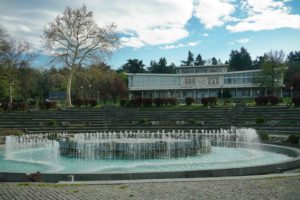 Vesna Pavlović, associate professor of art at Vanderbilt, arranged for me to meet historian and researcher Radovan Cukić at the Museum of Yugoslavia. Cukić enlightened me about finding photographic evidence for Sino-Yugoslavian political and cultural exchanges. He also taught me how to navigate their online photo database, offering to help me find these photographs in high-resolution. His insightful comments and suggestions for my honors thesis were invaluable.
Vesna Pavlović, associate professor of art at Vanderbilt, arranged for me to meet historian and researcher Radovan Cukić at the Museum of Yugoslavia. Cukić enlightened me about finding photographic evidence for Sino-Yugoslavian political and cultural exchanges. He also taught me how to navigate their online photo database, offering to help me find these photographs in high-resolution. His insightful comments and suggestions for my honors thesis were invaluable.
Visiting the Museum of Yugoslavia was also essential from an architectural perspective, as this very structure was designed by the same architect of the SIV building, Mihailo Janković. It was also a must-see for anyone traveling to Belgrade.
In the courtyard of the museum is the House of Flowers, the resting place of Josip Broz Tito. Formerly Tito’s auxiliary office with 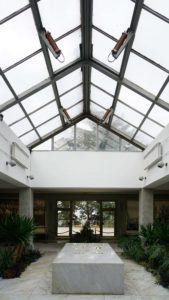 enclosed garden, this mausoleum also holds the most complete collection of Tito’s personal items, including a collection of more than 40 trophies presented to Tito in various representational forms of a hammer. I enjoyed talking with other visitors at the site as these brief conversations revealed how Tito was viewed by people from various social and cultural backgrounds: a group of Chinese government officials paying tribute to their “old friend” Tito, another couple from Britain finding their roots in their parents’ hometown, and a Spanish family unaware of who Tito was before coming to Belgrade.
enclosed garden, this mausoleum also holds the most complete collection of Tito’s personal items, including a collection of more than 40 trophies presented to Tito in various representational forms of a hammer. I enjoyed talking with other visitors at the site as these brief conversations revealed how Tito was viewed by people from various social and cultural backgrounds: a group of Chinese government officials paying tribute to their “old friend” Tito, another couple from Britain finding their roots in their parents’ hometown, and a Spanish family unaware of who Tito was before coming to Belgrade.
Traveling and researching in Belgrade was critical to my honors thesis because the former Yugoslavia is a political and ideological result that is remote and unimaginable to my mindset. Wandering the streets of Belgrade and viewing residential buildings that survived from that period, I can sense the vibrancy of Belgrade in the early 1960s: people full of hope and passion for a modern nation rebuilding their city after World War II. After rounds of conflicts and wars in the 1990s, the architecture of Belgrade by pioneering believers of modernism documented the broken society  and its history with concrete and steel. I will never forget the hospitality of the Serbian people, especially the scholars who helped me on this trip and my Airbnb host who was, with his father, waiting for me at the bus station when I arrived at four o’clock in the morning.
and its history with concrete and steel. I will never forget the hospitality of the Serbian people, especially the scholars who helped me on this trip and my Airbnb host who was, with his father, waiting for me at the bus station when I arrived at four o’clock in the morning.
I offer my sincere gratitude to the Downing family not only for their generosity in establishing a grant for student travel and research but also for their role in opening my eyes to the cultural significance of Belgrade and Ljubljana. I am deeply indebted to the History of Art Department for supporting my project and training me, especially Professor Betsey Robinson for offering generous support for my trip to Belgrade, and Professors Vivien Fryd and Elizabeth Moodey for advising me on planning this research trip. I also want to acknowledge Professor Vesna Pavlović with the Department of Art for generously guiding me through Belgrade and connecting me with scholars and institutions. Last but not least, I owe special thanks to my major advisor, Professor Kevin Murphy, and my thesis advisor, Professor Matt Worsnick.
Photographs courtesy of Qisen Song, BA’20: Tall buildings at center—Edvard Ravnikar, NLB Tower and TR3, Republic Square, Ljubljana, Slovenia, 1971; Mihailo Janković, Federal Executive Council (SIV) Building, Belgrade, Serbia, 1961; Mihailo Janković, Museum of Yugoslavia, Belgrade, Serbia, 1962; Tito’s Tomb, House of Flowers, Belgrade, Serbia, 1980; and Jože Plečnik’s desk as it was at his death in 1957, Hiša Plečnik, Ljubljana, Slovenia, 2016.
Posted by vrcvanderbilt on September 27, 2019 in HART, News, Student/Alumni, VRC
Susan DeMay Celebrates Retirement with Artist Talk and Reception on August 9
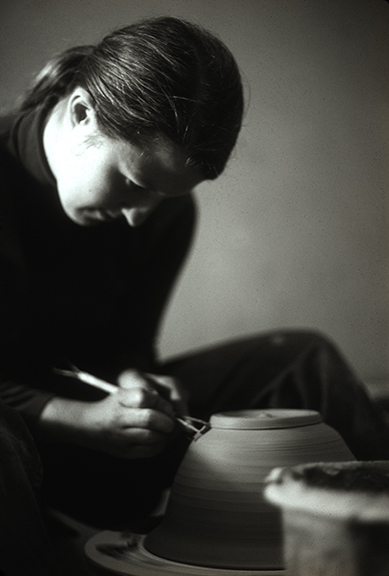 After nearly forty years of teaching, Susan DeMay, principal senior lecturer, is celebrating her retirement as a professor in Vanderbilt’s Department of Art. Currently on display in the Fine Arts Gallery in Cohen Memorial Hall, Divergent Practices: A Career in Ceramics, surveys ceramics that DeMay produced over decades of teaching, running her own production line, and creating artwork in clay.
After nearly forty years of teaching, Susan DeMay, principal senior lecturer, is celebrating her retirement as a professor in Vanderbilt’s Department of Art. Currently on display in the Fine Arts Gallery in Cohen Memorial Hall, Divergent Practices: A Career in Ceramics, surveys ceramics that DeMay produced over decades of teaching, running her own production line, and creating artwork in clay.
On Friday, August 9, at 5 pm, in her closing artist talk, “Making and Teaching Ceramics: Not Just for Fun,” DeMay will discuss her work and life, expanding on why making and teaching ceramics were not “just for fun”—a phrase she encountered often in her long and multifaceted career. Her talk will be held in Cohen 203, with a reception to follow in the atrium.
On view through September 13, the exhibition showcases selections from three bodies of work that DeMay has developed over the years. The first are pieces made for classroom demonstrations, which underscore technical methods as well as aesthetic considerations. The second group represents the colorful production works that DeMay fabricated while running a pottery business, with the help of as many as nine assistants. The third includes a suite of ceramics that are slab-constructed forms with unique surface treatments and hard, glassy glazes. These artworks are inspired by a wide-ranging set of visual references as well as traditional ceramic practices.
DeMay began pursuing ceramics as a graduate student at what was then known as the George Peabody College for Teachers, where she studied art from 1977 to 1979. After earning her M.S. degree and establishing a pottery studio of her own, she was invited to return to the Vanderbilt campus to teach. Subsequently she earned a second master’s degree (M.A., 1985) at Tennessee Tech’s Appalachian Center for Craft.
 Her ceramics have been shown at the Cheekwood Museum of Art in Nashville, the Evansville Museum of Arts, History & Science in Indiana, among other venues. Her production line has been sold at museum stores ranging from the Frist Art Museum and Tennessee State Museum in Nashville to the Smithsonian Institution, Washington, DC.
Her ceramics have been shown at the Cheekwood Museum of Art in Nashville, the Evansville Museum of Arts, History & Science in Indiana, among other venues. Her production line has been sold at museum stores ranging from the Frist Art Museum and Tennessee State Museum in Nashville to the Smithsonian Institution, Washington, DC.
The Fine Arts Gallery is located in Cohen Memorial Hall at 1220 21st Avenue South, on the western edge of the Peabody College campus. Parking is available in Lot 95 on the Peabody campus, accessible from 21st Avenue South.
Gallery hours for the month of August are Tuesday-Friday, noon to 4 pm; Saturday, 1-5 pm; closed Sunday and Monday. For more information, call 615.322.0605 (gallery) or 615.343.1702 (office).
*Kinchi Fukumoto. Susan DeMay trimming a bowl in her studio at Peabody College, 35mm slide (reproduction), 1978.
Posted by vrcvanderbilt on August 5, 2019 in Events, Fine Arts Gallery, HART, Lectures, News, Vanderbilt University, VRC
Vivien Fryd to Talk About Her Book on August 8 in California
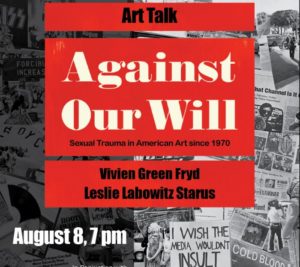 Vivien Fryd, professor of history of art, will speak about her latest book, Against Our Will: Sexual Trauma in American Art Since 1970 (The Pennsylvania State University Press, 2019) on August 8 at the Downtown Central Library, Glendale, CA.
Vivien Fryd, professor of history of art, will speak about her latest book, Against Our Will: Sexual Trauma in American Art Since 1970 (The Pennsylvania State University Press, 2019) on August 8 at the Downtown Central Library, Glendale, CA.
Her talk is in conjunction with 1 in 3: Sexual Violence Pandemic (July 12-September 1), an exhibit on view at ReflectSpace Gallery within the library. Fryd will appear on the Against Our Will panel with artist Leslie Labowitz Starus to discuss feminism in art. Headlined by a massive 23-foot wide interior mural by Starus, 1 in 3 considers the historical sweep of this violence with works and performance addressing the Asian Comfort Women of WWII, the anti-sexual violence efforts of the 1970s, and the current #Metoo movement.
Radio stations across the country have interviewed Fryd. Most recently, she was interviewed by Allison Dunne on WAMC (All Things Considered). Listen to the interview, “51%#1565: Documenting Sexual Trauma Through Art,” that aired on July 24.
Posted by vrcvanderbilt on July 31, 2019 in Events, HART, Lectures, News, Vanderbilt University, VRC
Christopher Johns to Present Paper on July 17 in Edinburgh, Scotland
Christopher Johns, Norman L. and Roselea J. Goldberg Professor of History of Art, will present a paper at the International Society for Eighteenth-Century Studies Congress in Edinburgh, Scotland, on July 17, whose overall theme is “Enlightenment Identities.” Johns will address “Enlightenment Naples Imagines Imperial China: Queen Maria Amalia’s Chinoiserie Boudoir in the Palace at Portici” in the session entitled “Identity in the Interior.”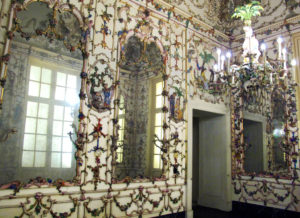
In 1743 King Charles VII of Naples and Queen Maria Amalia of Saxony established the Capodimonte Porcelain Factory outside Naples. As a princess of the Saxon Wettin dynasty, Maria Amalia was intimately familiar with the making of porcelain; the Electoral manufactory at Meissen, near the Saxon capital at Dresden, was the first place in Europe where hard paste porcelain was successfully produced. Scholars have long appreciated her leading role in the Capodimonte factory, but the Queen’s intense piety has largely camouflaged her enlightened ideas that were the ideological underpinning of the project. Her political role at the Bourbon court often favored reform and administrative efficiency.
Wishing to compete with the Meissen porcelain produced in her native Saxony (in Italy designated porcellana di Sassonia) and to manufacture a luxury product for export to ease the flow of metallic currency from the kingdom of Naples, a characteristically physiocratic notion, Maria Amalia was keenly interested in both the efficient production of high-quality porcelain and in its economic and diplomatic value.
Johns will focus his paper on the Queen’s boudoir at the palace at Portici outside Naples and its celebrated chinoiserie decorations. He argues that Maria Amalia, like many other eighteenth-century rulers, viewed chinoiserie not only as a fashionable fantasy but also as a visualization of modernity that doubtless appealed to Portici’s elite visitors and served as a marker of progressive ideas.
This session is intended to provide the basis for an anthology Bedrooms and Boudoirs in the Global Eighteenth Century to be edited by Johns and Tara Zanardi (Hunter College, New York). Zanardi presented the Goldberg Lecture in Art History on April 9, 2015, entitled “Porcelain Pleasures and the Allure of the East: Charles III and China.” She will present a paper in Edinburgh on the porcelain room at the Aranjuez Palace in Spain.
*Il Salottino di porcellana: Queen Maria Amalia’s Chinoiserie Boudoir in the Palace at Portici
Posted by vrcvanderbilt on July 15, 2019 in Conferences, Events, HART, Lectures, News, Vanderbilt University, VRC
Jennie Reisman: Maymester in Paris with HART Professor and Classmates
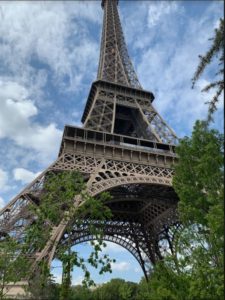 Imagine taking an immediate left out of your home to cross the street and stand on a bridge above the flowing waters of the Seine. Well, somehow that happened to my Maymester classmates and me … for an entire month. Having never been to Paris, I was astounded by the pure beauty of seeing the sun set over the Seine in the evening and the flickering lights of the Eiffel Tower at precisely 11:10 each night, without fail. I never imagined having the opportunity to walk along the streets of Paris observing an entirely different culture or weaving through the rooms in the Musée d’Orsay.
Imagine taking an immediate left out of your home to cross the street and stand on a bridge above the flowing waters of the Seine. Well, somehow that happened to my Maymester classmates and me … for an entire month. Having never been to Paris, I was astounded by the pure beauty of seeing the sun set over the Seine in the evening and the flickering lights of the Eiffel Tower at precisely 11:10 each night, without fail. I never imagined having the opportunity to walk along the streets of Paris observing an entirely different culture or weaving through the rooms in the Musée d’Orsay.
Prior to beginning my sophomore year at Vanderbilt, I never thought I would have a passion for learning about art. For the longest time I could not walk into a museum without wondering where the nearest exit was. Now, thanks to this Maymester trip led by Prof. Leonard Folgarait and the wealth of art history knowledge I have acquired in my HART classes, I no longer wander around in search of the red, glowing exit signs. Instead, I see art as a way to escape and a means of expression. Art does not have to make sense; in fact, it can be as abstract as a toilet seat containing a small signature, “R. Mutt.” I fell in love with the presentational, colorful components of Kandinsky’s art, Picasso’s distorted portraits of women, and the intricate designs of Yves Saint Laurent’s dresses. I also enjoyed sharing small vignettes with friends about some of the most famous works of art while wandering the halls of the Louvre.
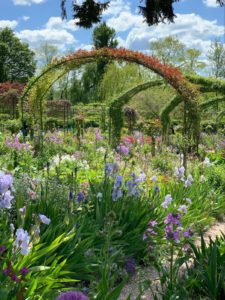 While in Paris, one of my most favorite mini-adventures was at Giverny, where Monet lived and painted his water lilies. Despite many days of rain and dreary weather before my visit, it appeared as though the flowers were unaffected. The gardens are the most picturesque site I have ever seen; I literally could not stop taking photos (in portrait mode, of course) of the amazingly unique petal designs and the wonderful arrangements of flowers. Continuing along the outskirts of the gardens, my friends and I arrived at the exact spot where Monet painted the water lilies. The weeping willows hung over the waters while the vines wrapped around the wooden beams of the famed bridge. The lily pads floated upon the surface of the water while the sun reflected off each and every pad. Now, this work of nature is one of the most beautiful works of art I have ever seen.
While in Paris, one of my most favorite mini-adventures was at Giverny, where Monet lived and painted his water lilies. Despite many days of rain and dreary weather before my visit, it appeared as though the flowers were unaffected. The gardens are the most picturesque site I have ever seen; I literally could not stop taking photos (in portrait mode, of course) of the amazingly unique petal designs and the wonderful arrangements of flowers. Continuing along the outskirts of the gardens, my friends and I arrived at the exact spot where Monet painted the water lilies. The weeping willows hung over the waters while the vines wrapped around the wooden beams of the famed bridge. The lily pads floated upon the surface of the water while the sun reflected off each and every pad. Now, this work of nature is one of the most beautiful works of art I have ever seen.
On the second weekend, I traveled to Amsterdam where I was greeted with delicious stroopwafels and bikers that nearly ran me over. Aside from the fact that my friends and I finally found a place that understood what iced coffee was, Amsterdam presented the opportunity to experience unique Dutch art alongside an emotional journey through the Anne Frank House. Not only was I exposed to a different style of art, but also I connected with my religion, Judaism, in an entirely new way.
Looking back, I still cannot believe that I managed to squeeze all of these events into a single month. The more I think about it, the more I want to go back. Although I felt as though I did so much, there is still so much more to see and experience. While in the Anne Frank House, a speaker in one of the short films said the following about Anne Frank, “All of her ‘would haves’ are our opportunities.” This quote perfectly sums up my experience in Paris for the month of May. In a way that I had only dreamed about, I experienced another beautiful part of the world from an entirely different perspective.
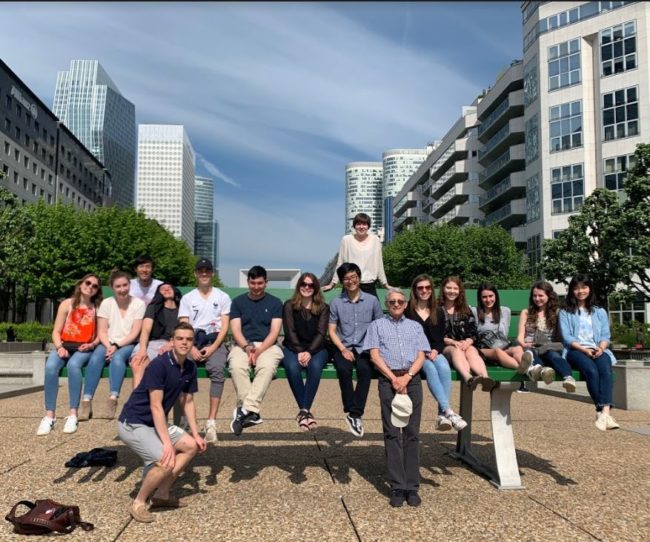 I hope to continue to learn new things and create my own stories, whether it be via traveling, immersing myself in different aspects of the Vanderbilt community, or attempting to discover something new about myself. I am so grateful to have had that experience, and for the remainder of the summer, I will continue to ask my parents when I can hop on the next flight back to Paris. Thanks, Mom and Dad!
I hope to continue to learn new things and create my own stories, whether it be via traveling, immersing myself in different aspects of the Vanderbilt community, or attempting to discover something new about myself. I am so grateful to have had that experience, and for the remainder of the summer, I will continue to ask my parents when I can hop on the next flight back to Paris. Thanks, Mom and Dad!
Jennie Reisman is a junior majoring in psychology, minoring in history of art, and following the pre-med track. After her month-long Maymester experience in Paris, she returned to work in the lab of Constantinos Koumenis in the Radiation Oncology Department, University of Pennsylvania.
“Specifically, my project focuses on the study of the Unfolded Protein Response (UPR) pathway, a series of signaling cascades activated in response to Endoplasmic Reticulum (ER) stress. When ER stress is mild or acute, the UPR has a pro-survival role; when the stress is chronic or severe, the UPR induces cell death. Identified as a potential target that regulates this dual role of the UPR was Survivin, a protein highly expressed in cancer cells but not in normal tissues. The aim of my study is to understand not only the mechanism by which Survivin regulates ER stress via the UPR, but also how its pharmacological targeting can be paired with ER stress-based therapeutic strategies to develop an effective cancer treatment. Through my participation in this research I hope to broaden my understanding of developing targeted cancer treatments as well as further pursue my interest in becoming a pediatric oncologist.”
Posted by vrcvanderbilt on July 3, 2019 in Events, HART, News, Student/Alumni, Vanderbilt University, VRC
Kevin Murphy and Alumna Mary Anne Hunting Explore Networks and Archives of the Cambridge School
 Kevin Murphy, department chair and professor of history of art, and Mary Anne Hunting, Vanderbilt alumna (BA’80) and independent scholar, New York City, jointly presented a paper at the annual symposium of The International Archive of Women in Architecture (IAWA) held March 20-22 in the School of Architecture + Design at Virginia Tech. Their talk, “Networks and Archives: The Cambridge School and Beyond,” focused on the personal and professional networks of students, faculty, alumni, and supporters of the Cambridge School of Architecture and Landscape Architecture (1916-1942) in Massachusetts.
Kevin Murphy, department chair and professor of history of art, and Mary Anne Hunting, Vanderbilt alumna (BA’80) and independent scholar, New York City, jointly presented a paper at the annual symposium of The International Archive of Women in Architecture (IAWA) held March 20-22 in the School of Architecture + Design at Virginia Tech. Their talk, “Networks and Archives: The Cambridge School and Beyond,” focused on the personal and professional networks of students, faculty, alumni, and supporters of the Cambridge School of Architecture and Landscape Architecture (1916-1942) in Massachusetts.
This all-women’s architecture school was founded to satisfy the needs of candidates excluded from the all-male Harvard architecture program or unwelcome at the nearby coeducational Massachusetts Institute of Technology. Eventually, the Cambridge School was absorbed by Smith College but was dissolved the moment Harvard accepted women into its architecture program when its enrollment sagged in World War II.
The Cambridge School fomented life-long connections between all who were associated with it. Not only did such faculty members as G. Holmes Perkins find a place in his office for recent graduates, but also the school’s director, Henry Frost, partnered with one of its earliest graduates, Eleanor Raymond. The women also formed networks as they fanned out across the country, working professionally in architecture, landscape architecture, interior design, publishing, merchandising, museums, and other fields.
“Our effort to explore these networks sent us across the country, from Maine and New Hampshire to Montana and California,” said Murphy. “While a few archives are housed in professionally managed institutions, such as the papers of Franziska Porgues Hosken in Harvard’s Frances Loeb Library, the work of most Cambridge School graduates are in the hands of their (now elderly) descendants.”
Murphy and Hunting examined case studies of selected Cambridge School graduates to show that their interconnections can only be understood through their archives, fragile and ephemeral documents of rich professional and personal relationships. Examples include Suzanne Stockard Underwood who transferred from the Cambridge School to Harvard in 1942; her papers are in the surviving home office she shared with her architect husband Julian. Others include Elizabeth-Ann Campbell Knapp, Princeton architect and Montana rancher, with archives now in a family office in Billings; and Ann Halle Little whose work is closely held in Philadelphia by her architect son.
Murphy and Hunting have previously worked together as scholars and architectural historians. Hunting received her doctorate from the City University of New York’s Graduate Center where Murphy was her advisor. Author of Edward Durell Stone: Modernism’s Populist Architect (W. W. Norton & Company, 2012), Hunting presented a lecture entitled “Edward Durell Stone, Modernist Architect: From Vanderbilt to Kennedy Center” as part of Vanderbilt’s Fall 2013 Homecoming events. Last year they jointly presented a paper, “The Professional Couples in Histories of American Modernism,” at the annual international conference of the Society of Architectural Historians.
*Cover of The American Home (June 1942) showing architects and partners Eleanor Raymond and Ethel Power at their summer house in Gloucester, Massachusetts.
Posted by vrcvanderbilt on June 25, 2019 in Conferences, Events, HART, Lectures, News, Student/Alumni, Vanderbilt University, VRC
Vivien Fryd Talks About Her Latest Book in Patmos
 “The #MeToo movement has had a sweeping effect on politics, organized religion, educational institutions, Hollywood, sports and the military. The cultural grip might be recent. The movement, however, is not,” said Vivien Fryd, professor of history of art, in a June 23 talk in Patmos, Greece. Fryd was invited to speak about her latest book, Against Our Will: Sexual Trauma in American Art Since 1970, published earlier this year by The Pennsylvania State University Press.
“The #MeToo movement has had a sweeping effect on politics, organized religion, educational institutions, Hollywood, sports and the military. The cultural grip might be recent. The movement, however, is not,” said Vivien Fryd, professor of history of art, in a June 23 talk in Patmos, Greece. Fryd was invited to speak about her latest book, Against Our Will: Sexual Trauma in American Art Since 1970, published earlier this year by The Pennsylvania State University Press.
Beginning in the 1970s, a group of female artists in the U.S. started confronting rape, incest and sexual assault through performances, videos, quilts and other nontraditional media. By tackling a taboo subject, they were at the forefront of raising public awareness of these issues. In her talk Fryd demonstrated how their relentless efforts to end the silence surrounding sexual violence against women and men reverberates in the #MeToo Movement today.
Throughout the spring Fryd was interviewed about her book by radio stations all across the country. Reviews of her book have appeared in bitchmedia, April 23, and The New York Review of Books, May 9, among others.
Posted by vrcvanderbilt on June 25, 2019 in HART, Lectures, News, Vanderbilt University, VRC
Christopher Johns Delivers Lecture at Southeast University in Nanjing
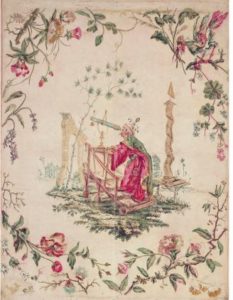 Christopher Johns, Norman L. and Roselea J. Goldberg Professor of History of Art, was invited to lecture in early June at Southeast University in Nanjing, People’s Republic of China. His lecture, “Chinoiserie: Europe Imagines China from the Late Baroque to Romanticism,” investigated the trajectory of chinoiserie, works by European artists inspired or influenced by the example of authentic works of Chinese art available in the West, including porcelain, lacquer, silk, and woodblock book illustrations, among other sources.
Christopher Johns, Norman L. and Roselea J. Goldberg Professor of History of Art, was invited to lecture in early June at Southeast University in Nanjing, People’s Republic of China. His lecture, “Chinoiserie: Europe Imagines China from the Late Baroque to Romanticism,” investigated the trajectory of chinoiserie, works by European artists inspired or influenced by the example of authentic works of Chinese art available in the West, including porcelain, lacquer, silk, and woodblock book illustrations, among other sources.
From tremendous enthusiasm for all things Chinese in the Late Baroque period, coupled with a highly positive image of China visualized in chinoiserie, during the eighteenth century an increasingly negative, even hostile, view of the Chinese led chinoiserie artists to depict China and the Chinese as decadent, insubstantial, and feminine. By the advent of Romanticism in the early nineteenth century, the negative view continued, but chinoiserie waned in popularity in favor of China as simply one of many exoticisms available to mix and match to fit into an imperialist view of non-western cultures.
*Jean Baptiste Pillement, The Chinese Astronomer, colored engraving, ca. 1765, New York, Cooper Hewitt Museum.
Posted by vrcvanderbilt on June 24, 2019 in HART, Lectures, News, Vanderbilt University, VRC
Betsey Robinson Leads Vanderbilt Tour from Rome to Sicily and Malta
 Betsey Robinson, acting chair and associate professor of history of art, grew up in Massachusetts and began her archaeological career with deep-sea exploration between mainland Italy and Sicily and work in paleontology and history of science. This month Robinson, a Mellon Faculty Fellow in Digital Humanities, is returning to the Mediterranean to introduce Vanderbilt alumni and friends to the mélange of cultures that flourished in the wake of ancient empires on this cruise to the shores of Italy, Sicily and Malta. Offered from June 20 to 28 by the Vanderbilt Travel Program, the tour from Rome, Italy, to Valletta, Malta, is entitled “Ancient Empires: A Voyage from Rome to Malta.”
Betsey Robinson, acting chair and associate professor of history of art, grew up in Massachusetts and began her archaeological career with deep-sea exploration between mainland Italy and Sicily and work in paleontology and history of science. This month Robinson, a Mellon Faculty Fellow in Digital Humanities, is returning to the Mediterranean to introduce Vanderbilt alumni and friends to the mélange of cultures that flourished in the wake of ancient empires on this cruise to the shores of Italy, Sicily and Malta. Offered from June 20 to 28 by the Vanderbilt Travel Program, the tour from Rome, Italy, to Valletta, Malta, is entitled “Ancient Empires: A Voyage from Rome to Malta.”
The tour affords the unique opportunity to travel with Robinson, a classical archaeologist and art historian, and a small, intimate group to seven UNESCO World Heritage sites. Italy’s stunning Amalfi coast and the colorful seaside town of Sorrento await the travelers. Robinson’s lectures will provide insight into Roman life of 79 CE in the superbly excavated town of Pompeii, Sicily’s storied town of Taormina, the legendary city of Syracuse, and Agrigento’s majestic Valley of the Temples. The tour concludes with Malta and its rich history, the island nation where Saint Paul was shipwrecked.
Since 1997 Robinson has conducted research at the Corinth Excavations of the American School of Classical Studies at Athens. She is currently working on projects on waterworks and ancient mosaics at Corinth as well as a new book on sacred Greek mountains and sanctuaries and their reflections in the art and literature of Rome and Constantinople.
*Amalfi Coast (courtesy of Wikimedia Commons)
Posted by vrcvanderbilt on June 20, 2019 in Events, HART, Lectures, News, Vanderbilt University, VRC
Christopher Johns Publishes Essay on Maria Tibaldi Subleyras
Christopher Johns, Norman L. and Roselea J. Goldberg Professor of History of Art, has written an essay, “Making History at the Capitoline Museum: Maria Tibaldi Subleyras’s Christ in the House of Simon the Pharisee,” which was published this year in Eighteenth-Century Studies (Volume 52, Number 2).
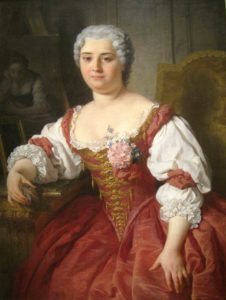 Johns wrote this essay in memory of Mary D. Sheriff—“scholar, teacher, and dear friend.” Maria Tibaldi Subleyras (1707-1770) is exactly the kind of “historically significant but relatively neglected artist who would have interested Mary, who devoted much of her career to illuminating the contributions of women artists like her.”
Johns wrote this essay in memory of Mary D. Sheriff—“scholar, teacher, and dear friend.” Maria Tibaldi Subleyras (1707-1770) is exactly the kind of “historically significant but relatively neglected artist who would have interested Mary, who devoted much of her career to illuminating the contributions of women artists like her.”
Maria Felice Tibaldi, one of the most important painters active in Rome in the mid-eighteenth century, was married to Pierre Subleyras (1699-1749), an expatriate French artist whose prominent career as a painter in Rome “largely overshadowed his wife’s remarkable achievements,” noted Johns. One of Tibaldi Subleyras’s paintings, Christ in the House of Simon the Pharisee (1748), was “very likely the first work by a living artist purchased for display in a public museum”—the Pinacoteca Capitolina established by Pope Benedict XIV Lambertini in 1751-1752.
Still on display in the Capitoline, it is a miniature copy in watercolor on vellum of her husband’s celebrated oil painting executed less than a year before he died. Its themes of penitence and charity, said Johns, “would have strongly appealed to Benedict XIV, who was one of the most notable figures in enlightened efforts to modernize the Church by stressing its duty to alleviate human suffering through institutions such as hospitals, almshouses, and shelters for penitent prostitutes.”
Tibaldi Subleyras was virtually forgotten by the art history world until the twentieth century. A number of recent exhibitions have focused on Pierre Subleyras, often including his portraits of his wife. “Is it not time to investigate Tibaldi Subleyras’s career independently of her husband,” asked Johns.
*Mary D. Sherriff (1950-2016), internationally celebrated art historian and beloved teacher, was the W.R. Kenan, Jr. Distinguished Professor of Art History at the University of North Carolina at Chapel Hill. She specialized in eighteenth-century French art and transformed the field by re-evaluating rococo painting, introducing feminist perspectives, and examining European art in a global context.
**Pierre Subleyras. Portrait of Maria Felice Tibaldi Subleyras, oil on canvas, ca. 1738-1739, Worcester Art Museum, Worcester, MA (courtesy of Wikimedia Commons)
Posted by vrcvanderbilt on June 20, 2019 in HART, News, Vanderbilt University, VRC

©2025 Vanderbilt University ·
Site Development: University Web Communications